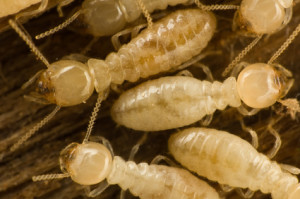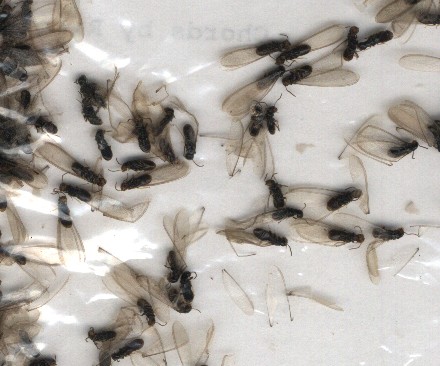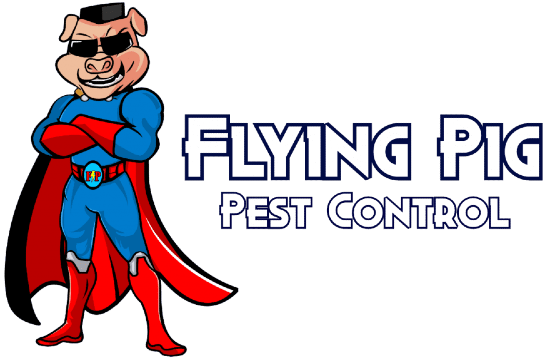Flying Pig Termite Control, Prevention, and Inspections
Flying Pig Pest Control provides termite control and inspections in Greater Cincinnati! Termites cause billions of dollars in damage to structures every year. Often undetected, subterranean termites in the Cincinnati area enter the structure from below the ground searching for wood and other cellulose material.

Worker termites, small 1/8″ foragers consume the material. From there, they take it back to the termite colony and feed it to other termites, including the queen. Their persistent and consistent foraging causes damage to structures. Eventually, this leads to structural damage. They continually forage night and day, as the survival of the colony depends on these hard workers.
In the Spring time, termite “swarmers,” or alates, emerge by the hundreds or thousands, usually on a warm, sunny day. Often mistaken for winged ants, these invaders are an indication that worker termites – the ones that damage the structure – are nearby. A diligent homeowner should consult a professional to help determine whether the swarmers are ants or termites. Proper identification is important!

Termite Inspections
Flying Pig Pest Control offers termite inspections in the Greater Cincinnati area. We offer wood-destroying infestation reports for the sale of homes and businesses at a very reasonable price. If you are buying or selling a home, Flying Pig Pest Control offers a Wood Destroying Infestation Inspection Report, using the required Form NPMA-33.
Related: Termite Inspections for The Sale of Your Home
For homeowners who would like a termite inspection, Flying Pig Pest Control provides a free, no-obligation inspection. This free inspection is for those that are not related to the sale of the home.
For more information or to schedule a termite inspection, contact us today.
Termite Treatment Options
When termites invade your home or business, you have to decide what termite treatment option you want implemented. Others make the decision to have a termite treatment program in place in order to prevent termites from entering the structure in the first place.
Soil Treatment
With a soil treatment, we inject a liquid termiticide into the soil around the foundation of the structure. This forms a continuous barrier. Flying Pig Pest Control offers this long-lasting soil treatment, providing protection of your home or business for many years to come. The treatment comes with an optional renewable guarantee, providing termite inspection and additional service as needed for a small annual renewal fee.
Because soil treatment involves the application of a continuous barrier around the structure, drilling is most often necessary in the treatment process. Because slabs such as patios, porches, and driveways may butt up against the structure, it is necessary to drill into the slab in order to inject the termiticide in the soil beneath the slab. The holes are normally drilled 12 to 18 inches apart. We seal it immediately after applying the termiticide.
Termite Baiting
Termite baiting involves the placement of bait stations installed around the structure. Usually, we place the bait within a few feet of the building. In many cases, the bait station is installed just outside the drip line, but as close to the structure as possible.
Termites find the bait stations by foraging through the soil. When they find the station, they mark the trail with a chemical, or a pheromone, that alerts the other worker termites to the trail. As this happens, it leads other worker termites to the station. Then, the termites feed on the bait, returning to the colony with the active ingredient.
This treatment comes with regular inspection and servicing of the stations. Additionally, it comes with an optional renewable guarantee, providing termite inspection and additional service as needed for a small annual renewal fee.
Termite baiting does not require the use of liquid chemicals, which is why some prefer this system over the soil treatment. It is the “greener” option in termite control.
Termite Prevention Versus Control
During termite treatments, most homes are treated when a termite infestation has been discovered. On the other hand, some home and business owners proactively have the structure treated before there an issue is discovered. For example, a home or business owner may decide to have a pest management professional install bait stations around the perimeter of their structure. With this, it allows foraging termites to find the bait stations before finding and damaging their house. Other homeowners prefer a continuous barrier of termiticide applied around the foundation of the home to prevent termites from finding the food source as well.
In the pre-construction phase, home and business owners may have the structure treated before the building is complete. One option is to have the soil treated before slabs are poured, forming a barrier both around and under the structure. If applied correctly and at the proper rate per label instructions, the termiticide will last in the soil for several years.
Another option is treating the exposed wood with a termiticide that prevent termites from consuming the wood.
When making a decision as to what type of treatment is best for you, do some research. When performing research on the Internet, visit reputable sites such as university websites (with the .edu extension), where you can obtain extensive research from entomologists.
